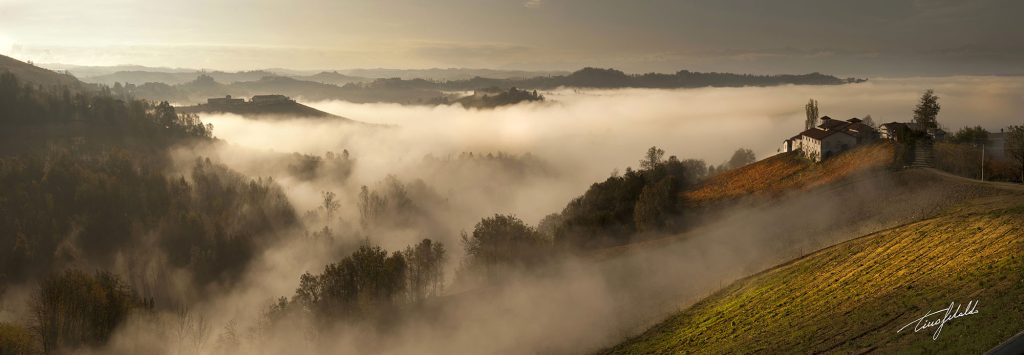
We’re talking Nebbiolo here, not the recovery from a classic New Year’s Eve hangover. The Nebbiolo grape is native to Italy’s Piemonte region, where the vineyards are often blanketed in fog at harvest time. The Italian word for fog is nebbia . . . from which some clever soul derived the name Nebbiolo.
Piemonte is located in Italy’s northwest corner, bordered on the west by France and on the north by Switzerland. Piemonte has more high quality (DOC and DOCG) wine appellations than any other Italian region. Although two-thirds of its production is red, it also produces some nice white and sparkling wines.
- Piemonte is also the philosophical soulmate of France's Burgundy. Its winemakers make their best wines from a single varietal, Nebbiolo, which is uniquely matched to the local terroir. The finest Piemonte wines are produced from a single vineyard, the equivalent to the Burgundy cru. Most Barolo producers make at least one single-vineyard wine.
Nebbiolo produces bold, highly tannic, but deceptively light-colored wines. The two most prestigious are Barolo and Barbaresco, named after the communes where they are produced. These are powerful wines that benefit from a decade or more of bottle age to allow the tannins to soften, and they can be cellared for several decades. While they can last decades, older wines become less fruity and display more leather and earthy notes, which is not to everyone’s liking. Nebbiolo wines are too intense for casual sipping and need to be paired with a hearty food.
- Barolo, often called the “king of wines and the wine of kings,” is the most powerful expression of the Nebbiolo grape. This is a densely textured wine with substantial tannins that long for a well-marbled steak. Barolo’s vineyards span a relatively large area, and there can be significant stylistic variations among zones. Making the effort to learn those differences, however, is the pinnacle of wine geekdom.
- Barbaresco is typically a slightly less alcoholic, intense, and tannic version of the Barolo. It is often thought of as the "queen" to King Barolo, although the two wines are becoming increasingly similar.
- Both Barolo and Barbaresco come in two distinct styles. The traditional style, which dominated until the 1980s, was highly tannic and unpalatable for a decade or more, until the tannins softened. The modern, more prevalent style is more fruit driven and approachable when young, although five to ten years of age is advisable.
Our wine of the week is a Pío Cesare 2008 Barbaresco (about $85 retail). It’s garnet colored, and shows earthy aromas, red fruit, spice, and roses on the nose. On the palate, the first thing that strikes you is the firm tannins. If you’ve never understood tannins, you will when you experience the rough, drying sensation on your gums and tongue after tasting this wine. The wine had muted flavors of dark red fruit and spice, a pleasant acidity, earthy notes, good balance, and a medium finish.
- This was a very nice wine, and nicely evolved after seventeen years. It’s a good value for a moderately priced Barbaresco and paired perfectly with our fatty ribeye.
- You’ll want to decant it for an hour or so.
- Other good producers include Gaja, Giacosa, Marchesi di Gresy, and Produttori del Barbaresco.
Cheers!
